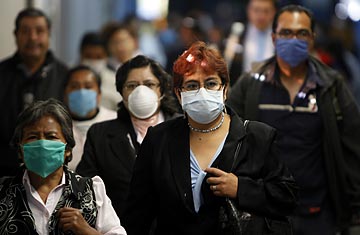
Residents of Mexico City wear masks as they exit the city's subway system.
As authorities around the world rush to work out where swine flu will turn up next, the movement of markets Monday was far more predictable. With cases of the new H1N1 virus confirmed from Mexico to Spain — and tests on possible cases underway from New Zealand to Britain — investors battled their own nerves. Recovering slightly from earlier losses, Britain's FTSE 100 index of leading shares was down just under 1% in early afternoon trading. Indices in France and Germany, likewise up on their earlier lows Monday, were nonetheless subdued amid the global jitters triggered by the spread of the flu virus. Earlier, shares in Hong Kong closed down 2.74%.
For investors already wounded by the global economic crash, news of a potential pandemic came as a further blow. "As if we didn't have enough to contend with," strategists at the Royal Bank of Scotland wrote in a note to clients Monday, "it's just what we need now, a flu pandemic in the midst of the biggest financial crisis since the Great Depression." Amid the sell-off, travel industry stocks fell sharpest. Shares in Lufthansa, Europe's second-largest airline, tumbled by more than 12% before recovering slightly. Those of rival British Airways pulled back from similar lows, trading 8% down by mid-afternoon in London. Tour operators and hotel groups took similar hits. (See pictures of the swine flu outbreak in Mexico.)
From the volatility of global travel, investors sought the calm of safe havens. Both the dollar and the Japanese yen rose against major currencies. Defensive stocks, such as pharmaceuticals, registered healthy gains. Shares in Roche, the Swiss maker of Tamiflu, an antiviral drug effective against swine flu, had climbed almost 6% by Monday afternoon. Rival GlaxoSmithKline, which makes the influenza treatment Relenza, saw its shares rise even higher. (Read: "Swine Flu: 5 Things You Need to Know About the Outbreak.")
How long stocks hold those positions in the face of the threat from H1N1 remains to be seen. The fact that shares hit hard early had regained lost ground Monday suggests markets had earlier "responded in the time honored fashion," says Howard Wheeldon, senior strategist at BGC Partners in London, namely with "a degree of overreaction."
Given the lack of clarity over the threat posed by the virus, that's perhaps understandable. But gauging the impact of the outbreak — for markets and economies just as for health officials — takes time. Should the virus's potential for a pandemic be realized, though, its financial impact would be severe. As with the outbreak of severe acute respiratory syndrome (SARS), which devastated the Asian economy in 2003, economic consequences would be measured "not so much in the number of people that go down with it, or unfortunately are killed by it," says Justin Urquhart Stewart, investment director at Seven Investment Management in London, but by "the impact of the potential [population] that could be effected. Once it starts to gather momentum, it takes very little to start knocking serious percentage points off global trade and GDP." Right now, that's a momentum we could all do without.
See pictures of the swine flu outbreak in Mexico.
Read: "Swine Flu: 5 Things You Need to Know About the Outbreak.
